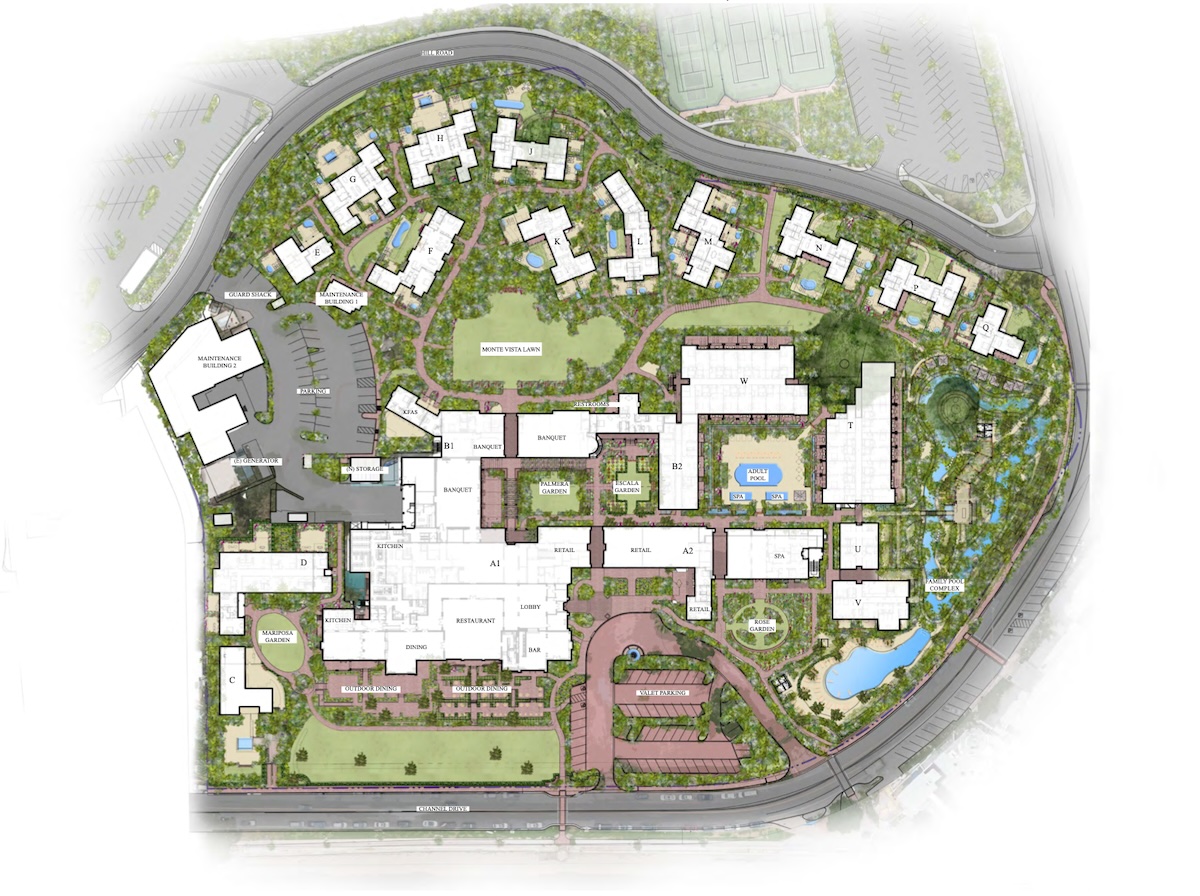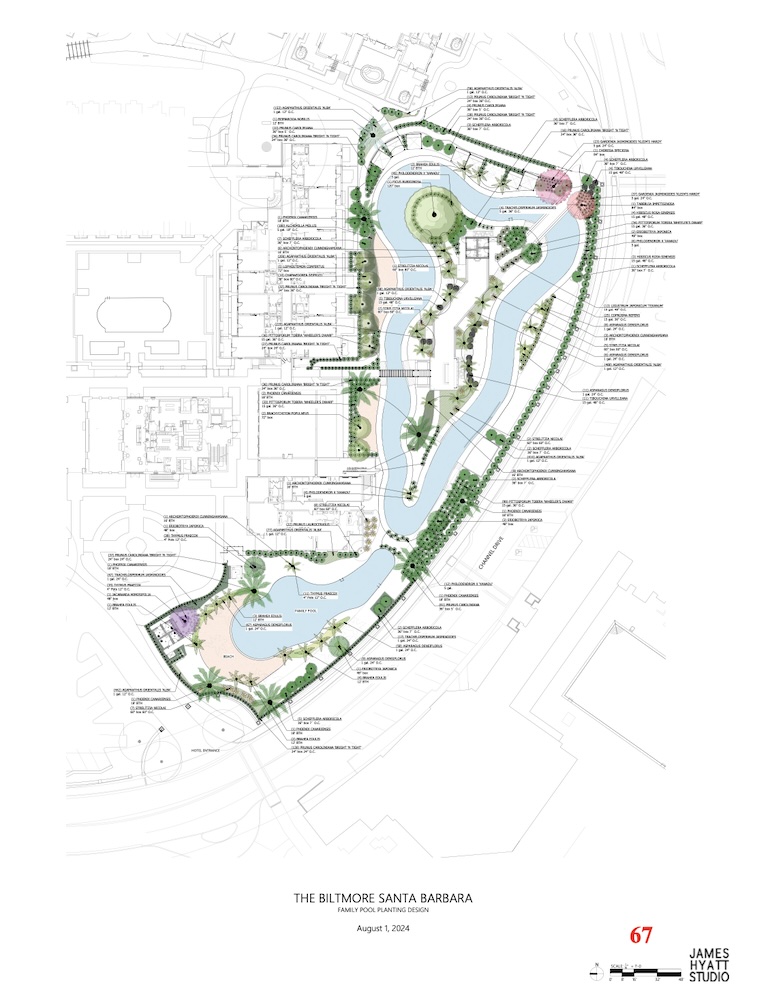Biltmore at the MPC: Schedules, Palapas, and More Discussed at Meeting

On Wednesday, October 16th, the Four Seasons Biltmore received preliminary approval from the Montecito Planning Commission (MPC) for its updated development plan. The plan includes adding private hot tubs for the bungalows, renovating the guest houses, building a new pool, and renovating the outdoor dining deck.
Ahead of the vote, the MPC requested that the size of the family pool be reduced by 5% and that the palapa in the pool area be covered with foliage so it could not be seen from Channel Drive. The Biltmore agreed to both requests.
The hotel received over a thousand letters of support from the community, according to the Biltmore’s Director of Development, Sean Lavelle, who held those letters at the meeting.

The hotel – owned by billionaire and Montecito resident Ty Warner – closed its doors in 2020 during the COVID-19 lockdown, leaving 650 employees furloughed and causing a consequent legal battle. The original plan was to renovate the resort and reopen in 2024; however, the reopening date is now projected for Summer 2025 because of permit setbacks. Approved plans, like renovating guest rooms into retail space, are underway, with some renovations already finished.
The Biltmore team hoped to clear the air regarding what they felt were misconceptions about the project, including the design of the bungalow hot tubs and the proposed family pool. The Biltmore assured commissioners that all designs aligned with the Spanish Revival style by the hotel’s original architect, Reginald Johnson. The shell of the hot tubs is fiberglass, but the visible part is tile. The hot tub concept is similar to those at San Ysidro Ranch, one of Warner’s other properties.
At the hotel’s last meeting with the Montecito Board of Architectural Review (MBAR), the board shared their thoughts on the project and made recommendations. At the meeting, some MBAR members vehemently opposed the additional pool concept and compared it to a “lazy river.” Following this meeting, the Biltmore team asked that the preliminary approval be denied. Then, they appealed that decision and presented it to the MPC.
“It was pretty clear it was the concept of the swimming pool that was the problem,” said Mark Lloyd, a private land use agency for the Biltmore. “It didn’t have to do with architectural details.”
Commissioners questioned the Biltmore’s decision to request an appeal. Commissioner Bob Kupiec asked Biltmore representatives why they would be reluctant to go back to MBAR since they had now made changes to the project that would accommodate them. Biltmore responded that they were hesitant to do this because one MBAR member stated they “would never be able to vote for our project.”
Still, Kupiec felt that the Biltmore should have received approval from MBAR. “Why wouldn’t you go back and get their approval… we aren’t a panel of architects, and they are,” he retorted.
Some of the changes that the Biltmore team made to their plans following the MBAR meeting include lowering the proposed height of the palapa at the new pool from 25 feet to 16 feet and making the top of the palapa “round-shaped.” In addition, they reduced the size of the dining deck at the La Marina Restaurant.
Chip Wullbrandt, a land-use attorney for the Biltmore, stressed the importance of getting these plans approved as they hope to open back up “as soon as possible” and estimated that this new Biltmore could generate “15 to 18 million dollars” in Transient Occupancy Tax (TOT) each year.
Tom Widroe of the Santa Barbara County Taxpayers Association stepped up for public comment to discuss the tax revenue. “One of the most exciting things about this project is that it will generate 15 million dollars or more in tax revenue for the county,” said Widroe. “I personally am concerned that if this project gets delayed and it goes past the July proposed opening of 2025, that’s 15,16,17 million dollars in tax revenue that our county needs.”
The Biltmore made some requests before the Commission, including changing the allotted construction times from Monday through Friday from 7 am to 7 pm to Monday through Saturday from 7 am to 7 pm. The commission denied this request, saying that it would further disrupt the neighborhood. Commissioner Donna Senauer said she “cannot support” Saturday work.
The Biltmore also requested that Bungalow R, one of the historic bungalows slated for relocation, be moved at night. The Biltmore said this decision is to avoid further disrupting neighbors, which the MPC supported.
Commissioner Sandy Stahl specifically requested information regarding the number of shops onsite when the Biltmore re-opens. The 1,680 square feet brought before the commission is in addition to a retail space approved in March. This project, already under construction, involves renovating guest rooms into 5,000 square feet of retail space. Stahl believed that the “whole thing” should have been brought before the MPC instead of the county approving the 5,000 square feet of retail space.
County staff cited Substantial Conformity Determination, an ordinance that grants the director and staff the authority to make small-scale modifications to projects, provided they adhere to certain guidelines. “That ordinance allows us to do it,” said a county staff member. “We review every project under that ordinance and criteria. It doesn’t come to your body, but if it doesn’t meet those criteria, then it comes before your body.”
Ultimately, county staff recommended that the MPC approve the project, which passed 3-1, with Commissioner Stahl being the only opposing vote. It will go before MBAR for final review on October 31.







You must be logged in to post a comment.